Chicago's architecture is famous throughout the world and one style is referred to as the Chicago School. Much of its early work is also known as Commercial style. In the history of architecture, the first Chicago School was a school of architects active in Chicago at the turn of the 20th century. They were among the first to promote the new technologies of steel-frame construction in commercial buildings, and developed a spatial aesthetic which co-evolved with, and then came to influence, parallel developments in European Modernism. A "Second Chicago School" with a modernist aesthetic emerged in the 1940s through 1970s, which pioneered new building technologies and structural systems such as the tube-frame structure.
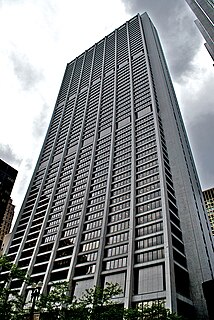
Chase Tower, located in the Chicago Loop area of Chicago, in the U.S. state of Illinois at 10 South Dearborn Street, is a 60-story skyscraper completed in 1969. At 869 feet tall, it is the eleventh-tallest building in Chicago and the tallest building inside the Chicago 'L' Loop elevated tracks, and the 40th-tallest in the United States. Chase Bank has its U.S. and Canada commercial and retail banking headquarters here. The building is also the headquarters of Exelon. The building and its plaza occupy the entire block bounded by Clark, Dearborn, Madison, and Monroe streets.
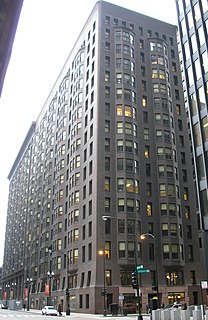
The Monadnock Building is a 16-story skyscraper located at 53 West Jackson Boulevard in the south Loop area of Chicago. The north half of the building was designed by the firm of Burnham & Root and built starting in 1891. The tallest load-bearing brick building ever constructed, it employed the first portal system of wind bracing in America. Its decorative staircases represent the first structural use of aluminum in building construction. The south half, constructed in 1893, was designed by Holabird & Roche and is similar in color and profile to the original, but the design is more traditionally ornate. When completed, it was the largest office building in the world. The success of the building was the catalyst for an important new business center at the southern end of the Loop.
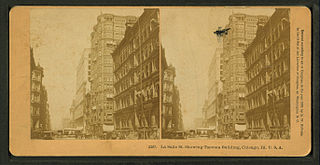
The architectural firm now known as Holabird & Root was founded in Chicago in 1880. Over the years, the firm has changed its name several times and adapted to the architectural style then current — from Chicago School to Art Deco to Modern Architecture to Sustainable Architecture.

The Gage Group Buildings consist of three buildings located at 18, 24 and 30 S. Michigan Avenue, between Madison Street and Monroe Street, in Chicago, Illinois. They were built from 1890–1899, designed by Holabird & Roche for the three millinery firms - Gage, Keith and Ascher. The building at 18 S. Michigan Avenue has an ornamental façade designed by Louis Sullivan. It was listed on the National Register of Historic Places on November 14, 1985, and was designated a Chicago Landmark on September 11, 1996. In addition, it is a historic district contributing property for the Chicago Landmark Historic Michigan Boulevard District.

The Sullivan Center, formerly known as the Carson, Pirie, Scott and Company Building or Carson, Pirie, Scott and Company Store, is a commercial building at 1 South State Street at the corner of East Madison Street in Chicago, Illinois. It was designed by Louis Sullivan for the retail firm Schlesinger & Mayer in 1899, and expanded by him and subsequently sold to H.G. Selfridge & Co. in 1904. That firm occupied the structure for only a matter of weeks before it sold the building to Otto Young, who then leased it to Carson Pirie Scott for $7,000 per month, which occupied the building for more than a century until 2006. Subsequent additions were completed by Daniel Burnham in 1906 and Holabird & Root in 1961.
7 South Dearborn was a planned skyscraper in Chicago, United States. Located at the intersection of Madison and Dearborn, the building would have been 1,567 feet (478 m) high, with twin antennas pushing the height to exactly 2,000 feet (610 m). The building would have been the tallest building in the Western Hemisphere at the time, if it were constructed.

The Marquette Building, completed in 1895, is a Chicago landmark that was built by the George A. Fuller Company and designed by architects Holabird & Roche. The building is currently owned by the John D. and Catherine T. MacArthur Foundation. It is located in the community area known as the "Loop" in Cook County, Illinois, United States.

The Arc at Old Colony is 17-story landmark building in the Chicago Loop community area of Chicago, Illinois. Designed by the architectural firm Holabird & Roche in 1893–94, it stands at approximately 215 feet and was the tallest building in Chicago at the time it was built. The building was designated a Chicago Landmark on July 7, 1978. It was the first tall building to use a system of internal portal arches as a means of bracing the structure against high winds.

The Printing House Row District is a National Historic Landmark District encompassing four architecturally important buildings on the 300 through 500 blocks of South Dearborn, South Federal and South Plymouth streets in the Loop community area of Chicago, Illinois. It was listed on the National Register of Historic Places as South Dearborn Street – Printing House Row Historic District and listed as a National Historic Landmark as South Dearborn Street – Printing House Row North Historic District on January 7, 1976. The district was designated a Chicago Landmark on May 9, 1996. The district includes the Monadnock Building, the Manhattan Building, the Fisher Building, and the Old Colony Building. The district overlaps significantly with the Printers Row neighborhood, and is not the same as South Loop Printing House District.

333 North Michigan is a skyscraper in the art deco style located in the Loop community area of Chicago, Illinois in the United States. Architecturally, it is noted for its dramatic upper-level setbacks that were inspired by the 1923 skyscraper zoning laws. Geographically, it is known as one of the four 1920s flanks of the Michigan Avenue Bridge that are contributing properties to the Michigan–Wacker Historic District, which is a U.S. Registered Historic District.

The Chicago Building or Chicago Savings Bank Building is an early skyscraper, built in 1904–1905. It is located at 7 W. Madison Street, Chicago, Illinois. It was designed by architectural firm Holabird & Roche, it is an early and highly visible example of the Chicago school of architecture.
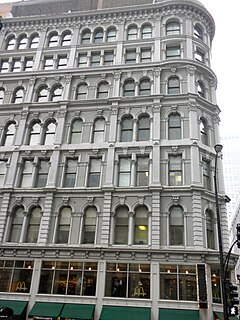
The Delaware Building is a building in the Chicago Loop built in the massive rebuilding effort after the 1871 Great Chicago Fire. It is significant for being one of the few buildings to maintain its 1870s character, as an Italianate structure, in an area dominated by more modern structures. The building is also notable for its early use of a precast concrete façade. The building was designated a Chicago Landmark on November 23, 1983 and listed on the National Register of Historic Places on July 18, 1974.

11 South LaSalle Street Building or Eleven South LaSalle Street Building is a Chicago Landmark building that is listed on the National Register of Historic Places and that is located at 11 South LaSalle Street in the Loop community area of Chicago, Illinois, United States. This address is located on the southeast corner of LaSalle and Madison Street in Cook County, Illinois across the Madison Street from the One North LaSalle Building. The building sits on a site of a former Roanoke building that once served as a National Weather Service Weather Forecast official climate site and replaced Major Block 1 after the Great Chicago Fire. The current building has incorporated the frontage of other buildings east of the original site of Major Block 1.

The University Club of Chicago is a private social club located at 76 East Monroe Street at the corner of Michigan Avenue & Monroe Street in downtown Chicago, Illinois. It received its charter in 1887, when a group of college friends, principally alumni of Harvard, Yale, and Princeton, founded the club hoping to further their collegial ties and enjoy intellectual pursuits.

The La Salle Hotel was a historic hotel that was located on the northwest corner of La Salle Street and Madison Street in the Chicago Loop community area of Chicago, Illinois, United States. It was situated to the southwest of Chicago City Hall and in very close proximity to St. Peter's Church. It was built between 1908 and 1909 by Holabird & Roche, contemporaneously with the Blackstone Hotel designed by Benjamin Marshall in a very similar style and at the time was Chicago's finest hotel.
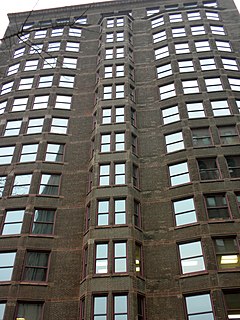
The Pontiac Building is a historic high-rise building located at 542 S. Dearborn St. in the Printer's Row neighborhood of Chicago, Illinois. Built in 1891, the building is the oldest surviving work in downtown Chicago designed by the architecture firm Holabird & Roche. The fourteen-story building represents the Chicago school of architecture and is designed as a steel frame covered in brick. The building's Dearborn Street facade features three tiers of bay windows, while the facade on Federal Street features one tier of bay windows flanked by two tiers of flat windows; while the outer two tiers on both facades each span two bays, the middle tier spans only one. The bottoms of these tiers of windows, located at the second floor of the building, feature terra cotta soffits; the building's cornice is also terra cotta. The first two floors of the building feature limestone piers with decorative capitals. Due to the building's architectural significance, it was added to the National Register of Historic Places on March 16, 1976.
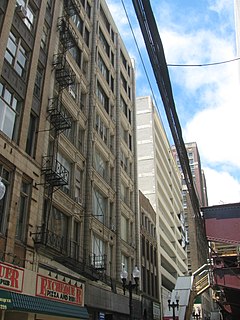
The McClurg Building is a historic skyscraper in the Loop community area of Chicago, Illinois. The building was built in 1899 and designed by Chicago school architects Holabird & Roche. At nine stories tall and 80 feet (24 m) by 150 feet (46 m) at its base, the building is one of the smallest skyscrapers in Chicago. The building's Wabash Street facade has 9,000 square feet (840 m2) of windows bordered by terra cotta piers and spandrels; the amount of window space was necessitated by the absence of windows on the sides of the building. The A.C. McClurg publishing company was the building's main occupant and gave the building its name.

The Crane Company Building is a skyscraper located at 836 S. Michigan Ave. in the Loop community area of Chicago, Illinois. The twelve-story building was designed by Holabird & Roche and built in 1912. The steel frame skyscraper was designed in the Classical Revival style, and its exterior design is split into three sections. The first and second floors are faced in limestone and feature piers supporting a cornice; the third floor is also covered in limestone. The fourth through eleventh floors are constructed in red brick; windows on these floors feature terra cotta keystones and sills, and the eleventh floor is capped by a terra cotta cornice. The twelfth floor is decorated in terra cotta panels which incorporate Crane Company valves in their design; this floor is also topped by a cornice.

The Buckingham Building is a 27-story skyscraper located at 59-67 E. Van Buren St. in the Loop neighborhood of Chicago, Illinois. The building, which opened in 1930, has historically served as a mixed-use retail and office building. Chicago architects Holabird and Root designed the building in the Art Deco style. It was added to the National Register of Historic Places on August 10, 2000.



















